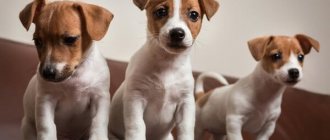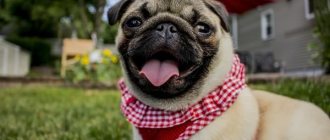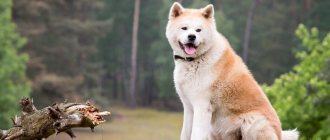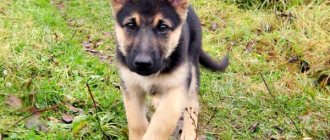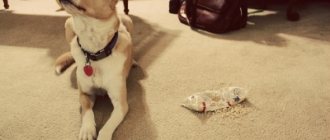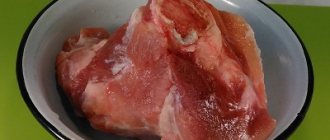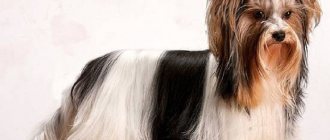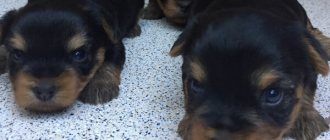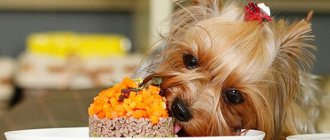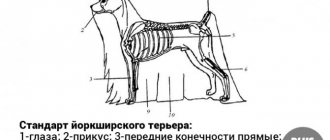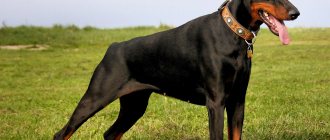The breed to which the pet belongs determines not only its appearance and character, but also its needs regarding nutrition, living conditions and care.
It should be noted that caring for a pet is not at all difficult.
A loving, caring owner will make every effort to provide his four-legged friend with everything he needs and maintain his good health.
Speaking about the Akita Inu, it is worth noting that care, which, in the opinion of many, seems labor-intensive, is in fact enviably simple.
Are they difficult to care for?
Caring for an Akita Inu is not difficult . Unpretentious by nature, dogs are not prone to whims in nutrition and eat both natural products and industrial food equally well.
Coat care does not require mandatory haircuts or trimming and is limited to regular combing and occasional washing.
Long active walks are what Akita Inu really needs . It is important to allow your pet to waste its energy; this has a positive effect on its development and health.
You don’t have to come up with complex, original games; the dog will be happy to simply bring the owner a ball or a found stick.
Origin story
The ancestors of the American Akita are Japanese dogs from the Akita region. In their homeland they took part in dog fights. After fighting was banned (1908), the breed began to develop as a large Japanese dog. During World War II, she had a hard time - dog skins were used to sew warm clothes and for other economic purposes. There have been attempts to save the breed by crossing it with the German Shepherd.
After the war, the breed began to revive. Her journey across the continents began. American soldiers returned home and took with them cute dogs that looked like big teddy bears. This is how the Akita came to the USA and began to be called American. In Japan, Akitas developed according to their own canons, in the USA - according to their own. Later, these two varieties were separated into separate breeds.
How to care for a puppy
The first thing you need to do is show the puppy his personal place, which should already be arranged . If it’s warm outside and you plan to keep your pet in an enclosure, you can immediately place the puppy in it, otherwise you need to show him a place in the house.
CAREFULLY!
You cannot change the puppy's diet for several weeks - he should eat the same food as the breeder gave him.
Puppies should not carry heavy objects or run a lot until about 1.5 years of age, when their joints are stronger.
Hygienic care includes regular combing of the coat, trimming of nails, cleaning of teeth and ears..
It is necessary to accustom the puppy to these procedures from an early age.
An adult dog
You should follow the vaccination schedule, promptly treat for internal and external parasites, feed your pet a balanced diet - all these factors affect the pet’s health and its life expectancy.
In general, caring for an Akita Inu is almost identical to caring for other breeds and consists of brushing the coat, brushing teeth and ears, and trimming nails..
Adult Akitas are still energetic and active and need regular long walks. Perhaps this is one of the key conditions for proper and caring care for a pet of this breed.
Akita Inu character
- Smart
- Independent
- Devoted
- Stubborn
- Wayward
- Cheerful
- Vigorous
- Brave
- Dominant
- Independent
In Japan, the Akitua Inu has become a symbol of fidelity and selfless love.
What conditions make up a dog's character? It is widely believed that the character of a four-legged pet is determined at the genetic level. Also, many people close to cynology argue that character traits are nothing more than the consequences of training and daily upbringing of a puppy. The conditions under which the pet is kept also play an important role. You should not expect your pet to be sociable and friendly towards people if he has been shouted at since childhood, waved at with a leash, or with a newspaper.
Experienced dog breeders will certainly say that if you want to achieve mutual understanding with your own pet, then you must match in temperament and in some character traits. To correctly choose the breed that suits you, first study this issue theoretically: consider the exterior of the dogs you like, read the breed standard, pay attention to the description of the temperament and characteristics of the breed's behavior, ask questions to the real owners of the breed you are interested in. If, in theory, you are satisfied with the breed of your future pet, go to a nursery, or to people engaged in private breeding. A competent breeder who cares about his breed will readily respond to your requests for help in selecting a puppy. It is difficult to say with certainty what kind of character your chosen dog will grow up to be in such a short period of time. There are several simple tests with which you can choose a little friend with the qualities you need.
Vaccination schedule
| Age | Vaccine option |
| 8-9 weeks | Nobivac DHPPI + Nobivac L Eurican DHPPI + Eurican Duramune Max5-CvK/4L |
| 12 weeks | Nobivac DHPPI + Nobivac L+R Eurican DHPPI + Eurican L+R Duramune Max5-CvK/4L(+ after 21 days Nobivac R) |
| At 1 year and annually thereafter | Nobivac DHPPI + Nobivac L+R Eurican DHPPI + Eurican L+R Duramune Max5-CvK/4L (+ after 21 days Nobivac R) |
You cannot vaccinate an unhealthy puppy, and 10 days before vaccination it is necessary to carry out deworming.
Expert opinion
Kozhevin Semyon Kirillovich
Expert dog handler.
Akita Inus are suitable for active people who have free time, as they need long, active walks. It is also necessary to feed these dogs correctly, taking into account the characteristics of their body and health. These are the 2 main components of proper care that allows you to raise a strong, healthy dog. Grooming also includes brushing the fur, trimming the nails, and cleaning the teeth and ears.
What you need to prepare
You should purchase products in advance to help ensure proper care for your dog.:
- wide-toothed comb;
- slicker;
- massage comb or brush with natural bristles;
- toothpaste;
- collar and leash;
- nail clipper;
- 2 bowls on a stand;
- toys;
- veined bone;
- a bed, bedding or rug;
- muzzle;
- feed;
- shampoo and conditioner;
- disposable hygiene diapers.
Cotton swabs, napkins, and towels for washing your pet can always come in handy.
First days at home
Finding itself in an unfamiliar environment, the puppy experiences stress, so it is important to ensure a calm, quiet environment in the house: you should not invite guests, play music loudly, if there are children, you should not allow them to grab the puppy.
The dog needs time to adapt and also to get used to its name.
The puppy is scared and may whine and ask to be held. You can soothe him in your arms, but you should not carry him constantly, otherwise he will never become independent.
At night, the pet may ask to go to bed with its owner, believing that this is the only safe place.
If you do not plan to allow an adult dog to sleep in the owner's bed, you should not allow the puppy to do so either . It is better to place his bed near the bed and touch the puppy when he whines.
To quickly adapt, you should not leave the puppy in the house alone, but if this is necessary, you need to limit its space by locking it in the smallest room and leaving it with toys.
Personal place
If an Akita Inu lives in a house or apartment, it is necessary to create a place for it in the corner of a closed room, where the dog can sleep or simply relax and hide from the attention of prying eyes.
You need to put there a moderately hard but cozy special bed (blanket or rug), the size of which will allow the dog to stretch out freely during sleep and generally feel comfortable.
Feeding and diet
Akita Inu dogs are unpretentious in food, which allows them to be fed with natural products, ready-made industrial food, and even a mixed diet..
However, we should not forget about the likelihood of developing an allergic reaction or food intolerance, as well as the balance of dietary supplements and vitamins and minerals, so the choice of nutrition should be approached responsibly.
A natural diet should include:
- dairy products;
- lean meat;
- boiled offal;
- eggs;
- millet, rice, buckwheat;
- vegetables;
- fruits (after 4 months).
The serving size is calculated based on the pet’s weight: 400-500 g of food for every 30 kg of weight. Natural nutrition involves additional intake of vitamins and minerals - this helps to avoid joint problems in your pet, as well as improve the quality of the coat.
IMPORTANT!
It is necessary to control the amount of protein food, because Excess proteins lead to the development of allergies, characterized by dermatitis and digestive disorders.
In the case of feeding industrial feed, preference should be given only to high-quality products of at least premium class, and better yet, super premium class, since they are made from the most natural ingredients and contain a vitamin and mineral complex.
The number of feedings per day depends on the age of the dog:
- up to 2 months - 5-6 times;
- 2 months - 5 times;
- 3 months - 4 times;
- 4 months - 3 times;
- After six months, you should gradually accustom the dog to feeding twice a day.
In case of low physical activity and light loads, the Akita Inu can eat once every 2 days.
Feed
The basis of the diet of these dogs in their homeland, Japan, is rice, fish and seafood, seaweed, and vegetables. Purebred Akitas are adapted specifically to this diet. They very often have an allergic reaction to chicken, beef, fatty dairy products, wheat, corn and oatmeal. To feed puppies of the Japanese dog Hachiko, you should stock up and always have boiled sea fish, low-fat cottage cheese, veal, fruits and vegetables at the ready. It is difficult for an adult dog to choose suitable dry food, since the soy contained in ready-made mixtures is poorly digestible by Akitas. It is optimal to stick to food that has only one source of protein - fish or duck. The protein proportion should be a maximum of 26%.
How often should you go for walks?
You need to walk your Akita Inu at least 2 times a day for 2 hours. At the same time, it is still better if there are more walks and they last longer.
Walking is required not only for domestic dogs, but also for dogs living on the street..
Regular walks, physical activity, active games, training and communication with the owner and other animals (provided the pet does not have zoo aggression) have a positive effect on the health and development of the dog.
Description
Appearance and photo
A large, powerful, Spitz-shaped dog with a strong, proportional build.
| Height at withers | Males from 64 to 74 cm Bitches from 58 to 64 cm. |
| Weight | Males from 32 to 39 kg Bitches from 23 to 29 kg. |
| Color |
|
| Wool | Hard and straight, with a dense undercoat. |
| Nose | Black, pigmentation is allowed only with black color. |
| Ears | Standing. |
| Language | Pink, no blue or black pigmentation. |
Wool consists of three layers. The top layer is coarse and long wool. Underneath is a layer of wool that is shorter, but just as coarse and tough. The third layer is the undercoat, a very soft and short coat. The hair on the shoulder blades and paws is longer than on other parts. The tail has the longest hair. For a purebred Akita, only three coat colors are allowed.
We invite you to look at the photos of the dogs.
Character
They are very active and require a lot of attention, which disappoints many people who dream of a calm and quiet pet. Representatives of this breed are very smart. The only drawbacks are their stubbornness and curiosity.
Due to excessive stubbornness, they are difficult to train. And with every rustle, the dog will go to its place to find out the reason. Therefore, it may seem like there is too much dog. They are willful, have leadership qualities and are very jealous. Therefore, most often the Akita does not get along with other animals, especially dogs. A well-trained Akita can tolerate its relatives, but will try with all its might to show perfection over them.
She is very reserved and not dangerous towards people. They are playful, friendly and cheerful by nature. Gets along well and enjoys playing with children.
Reference. There is evidence that Japanese aristocrats often used Akitas as nannies.
Health and life expectancy
They are distinguished by endurance and good health and immunity. Life expectancy can reach up to 15 years. But like other dogs, there are a number of diseases that are typical for this breed. Veterinarians consider congenital articular dysplasia to be the most common disease among Akitas.
They are also predisposed to diseases associated with thyroid dysfunction. For preventive purposes, it is necessary to conduct regular examinations in the clinic. Food supplements containing iodine are also considered preventive measures.
Akitas have a physiological feature called microcytosis. This means that the size of red blood cells in the blood is much smaller than in other animals. This is not considered a deviation from the norm; rather, it can be called a feature of this breed. Microcytosis does not pose any threat to the health and life of the pet.
Important! Akitas are difficult to tolerate anesthesia. This fact must be taken into account when choosing a location for operations.
The veterinary clinic must have resuscitation equipment.
Also susceptible to skin diseases such as:
- Pemphigus.
- Seborrhea.
- Dermatitis.
In terms of cleanliness, the Akita can be compared to a cat. The dog is very clean and carefully looks after its coat on its own. The owner can only comb and wash his paws after a walk. Virtually odorless. In those houses or apartments where an Akita lives there is never a smell of “dog”.
Peculiarities
The peculiarities of this breed include the fact that quiet dogs are not trimmed or cut.
This breed sheds heavily. Molting occurs twice a year for several weeks. During this period, it is recommended to comb your pet every day. It is recommended to bathe Akita 2-3 times a year only with specialized bathing products. After bathing, the coat must be dried with a hairdryer or towel.
The dog can be kept both on the street and in an apartment or house. Thanks to her warm fur coat, she is not afraid of frost. An outdoor Akita needs a spacious booth with an insulated floor. If the dog will live indoors, then it needs active walks for 1.5 - 2 hours 2-3 times a day.
Can he live on the street?
Thanks to the structure of the coat and thick, dense undercoat, Akita Inu tolerate cold well and can live outside even in winter, provided several requirements are met.:
- the enclosure should be insulated and located in a place that is not too accessible, but provides sufficient visibility;
- There should be a warm layer of blankets or straw inside the enclosure;
- It is necessary to provide your pet with warm food and water.
You cannot put an Akita Inu on a chain - this is associated in the dog with a loss of freedom and has a negative impact on its mental and physical state.
Pet training
Akita training deserves close attention and attention, since it simply cannot be done without it. Akita Inu has serious muscles that need to be developed day by day. From the age of six months, you can take your puppy to a dog training area. Of course, he won’t immediately start following commands and exercises, but he will run around interesting devices and slides with interest.
Akita is a very intelligent dog with a playful and good-natured disposition. She is easy to train due to her curiosity and thirst for physical activity. Owners can be sure that their pet will withstand any stress and testing, since it is difficult to find an animal with greater endurance and stubbornness. Some continue to use this breed for hunting, but this is not common. Due to its popularity, Akita Inu is most often kept in apartment conditions. But, despite the animal’s place of residence, it is necessary to carry out daily training and long walks.
As soon as the dog has crossed the threshold of the apartment, it will imposingly begin to inspect the territory. Any item on the floor will be subject to thorough testing, both for smell and taste, so everything should be removed. Under no circumstances should you hit a puppy. He will leave nothing but anger in his memory.
If the puppy has misbehaved, you need to use a threatening tone to indicate that he was wrong, and this should be done immediately after the offense. Young dogs have a very short memory, so if you punish the dog after half an hour, it simply will not understand why it was reprimanded.
Diaper training
If your dog lives in an apartment and you need to teach it to relieve itself in a diaper, you should:
- take your pet to the diaper immediately after he wakes up or eats;
- at first, keep the puppy in a limited area, where several diapers will be spread on the floor - this leaves the dog practically no alternative and helps to quickly remember where the toilet is;
- if it is impossible to briefly limit the dog’s movements, then you should spread the diapers in several places: near the door, balcony, under the window and in places that the dog has chosen itself, gradually reducing their number.
You can also use special sprays by spraying them on diapers - they emit a specific smell that indicates to the dog that this is a toilet.
You need to accustom your puppy to a diaper from the first days in a new home..
Interesting facts about Akita Inu
- A long time ago, in Japan it was believed that the Akita Inu dog attracted good luck and prosperity to the home. Therefore, this breed was protected. There was even a law that severely punished people who harmed a dog.
- The nickname of the most famous dog of this breed, Hachiko, translates as eight. The owner called him that because he was his owner’s eighth dog.
- In the USA, this breed is mainly used as bodyguards. They confirm their vocation for the role of bodyguards annually at specialized competitions. In Japan, dogs are used in rescue operations.
- Akita Inus are often called smiling dogs; thanks to their anatomy, they always have a good-natured smile on their face.
- In 1934, a monument was erected to the dog Hachiko for the dog’s amazing loyalty to his owner even after death. Hachiko was personally present at the opening.
If you decide to get a dog, then get ready for the following: you will often have to clean up little mistakes after your puppy; investments will be required in annual vaccinations, feeding, toys, ammunition, etc.; any animal requires attention and communication, so if you don’t have time, then there will be no mutual understanding with your Akita Inu puppy. Big changes are coming in your life. If you can handle this, you will find a loyal friend for life. Akita Inu color
Akita Inu Color is a canine term that refers to the color of a dog's coat. It is one of the most important traits in breeding... Read more
Akita Inu training and education
Akita Inu Raising a dog is about developing correct behavior. This is the basis for successful training. Training is a set of activities aimed at… Read more
Character of Akita Inu: who is better to take a bitch or a dog?
Akita Inu The character of a dog depends on heredity and breed characteristics, but proper upbringing and training is also of no small importance. In the article... Read more
Akita Inu diseases
Akita Inu Each breed of dog has a predisposition to certain diseases. We have collected information about typical diseases of the breed. Remember the symptoms of the disease, the risk... Read more
Akita Inu
How to trim claws correctly and when?
Too long nails do not allow the dog to position his paws correctly, which causes the load on the ligaments and joints to be distributed incorrectly, so the nails must be trimmed regularly.
This should be done monthly using a nail clipper designed for large dogs . After trimming, the sharp edges need to be filed with a file so that the claws do not peel off.
The claws must be shortened carefully, without touching the blood vessels or causing pain to the pet, to such a length that the dog does not “clack” on the floor when walking.
How to clean your ears
Akita Inu have open ears, in which dirt, dust and excess wax accumulate. This problem is especially relevant for street dogs.
It is necessary to clean your pet’s ears 1-2 times a week with a cotton pad soaked in a special lotion..
Healthy ears should not have an unpleasant odor, and they should have a pink tint.
Mating
If you decide to start breeding this exotic and noble breed, then choosing a partner for mating will probably present certain difficulties.
It is important that all the weaknesses of the breed in the female must be compensated by the advantages of the male and vice versa.
Key indicators to pay attention to:
- pedigree;
- titles;
- appearance;
- character and aggressiveness;
- health level.
For mating, the male must be at least 10 months old, and the female must be at least 15 months old.
The favorable period for conception is 10-14 days after the start of estrus.
A healthy female of the breed gives birth to 2 to 7 puppies.
The decision to get a dog is always a very responsible step, which needs to be approached seriously and thoughtfully. Akita Inu are ideal for both indoor and outdoor use. This is a true friend and a full-fledged family member. With proper care, it will be faithful to you for many years.
Grooming
Soft, plush-like wool of medium length with a thick undercoat is the calling card of representatives of this breed. At the same time, the coat requires minimal care, which does not take much time.
These dogs do not need any haircuts or trimming..
You need to comb your pet 1-2 times a week, first with a wide-toothed comb, then with a slicker brush to get rid of dead undercoat hairs, and then with a massage comb or a natural bristle brush.
NOTE!
Akita Inu sheds twice a year for several weeks; as a rule, these periods occur in January-February and May-June.
At this time, abundant hair loss occurs, which brings inconvenience not only to the pet, but also to its owner. Daily brushing can improve the situation.
During the molting period, to maintain a healthy coat of the dog, you should give it mineral supplements..
Sterilized animals living indoors or in a climate that excludes major seasonal changes do not shed excessively.
Description of the breed
In the external features of the American Akita, one can easily discern its Japanese ancestor - the Akita Inu. They share common features of the muzzle, head and body. However, despite such a close family connection, it is immediately apparent that the American representatives of the breed primarily differ from the Japanese:
- much more impressive dimensions;
- spotted colors and other shades of wool;
- the shape of the head, which in American Akitas is somewhat larger and wider than in Japanese ones.
The American Akita has an impressive size
The height of these dogs at the withers according to the breed standard should be:
- for males - 72 centimeters;
- for females - 67 centimeters.
The dog has wide bones and well-developed muscles. The weight of American Akitas is 25-30 kilograms higher than that of their Japanese ancestors! So, the following indicators are characteristic:
- for Akita Inu, the maximum body weight can be 45 kilograms;
- For the American Akita, the maximum possible body weight is 70 kilograms.
As for the nuances and parameters of the exterior, the American Akita has the following characteristics.
Table 1. Exterior of the American Akita
| Parameter | Characteristic |
| Eyes | The eyes of dogs of this variety can be described as small in size. The iris is usually brown, the shades within it may vary |
| Nose | American Akitas have a standard black or dark brown nose. If white predominates in the color of the animal, then the nose may also be a slightly lighter brown shade; this is not considered a defect in the breed |
| Ears | The ears of these dogs are small. Relative to the head, they are located in a vertical position, while slightly tilted towards the animal’s nose |
| Neck and head | The animal's head is large and wide. The frontal lobe protrudes noticeably forward, having a prominent junction. The animal's neck is very developed and muscular |
| Limbs | The paws of American Akitas are large, muscular and even sinewy. They are located clearly parallel to each other. The pads on the limbs of animals are fleshy, the ends of the paws are large |
| Tail | The tail is evenly covered with fluffy hair throughout its entire length, while it itself is of medium length. Its shape is ring-shaped, it looks like a real decoration of this animal |
Akita's beautiful chocolate eyes are mesmerizing
Wool
The coat of these dogs is very pleasant to the touch, thick and soft due to the abundantly growing undercoat. It is straight in structure. The entire body is the same length, with the exception of some places where it is slightly shortened:
- heads;
- paw
However, the specific length in millimeters for wool has not been determined; this parameter may vary.
The colors can be absolutely any. However, there is a condition: if there are spots on the dog’s body, then they must have a clear demarcation from the other color areas. The coloring should be uniform, with a discrepancy between the colors of the undercoat and the long coat allowed.
Long-haired Akita is a long-haired variety of the breed.
Representatives of the second variety have longer fur, as you already understood, due to which “pants” are formed on its paws. In addition, due to this interesting feature, animals look much more voluminous and fluffier:
- tail;
- ears.
Interestingly, this mutation is not a deviation from the breed standard, but in itself it is a genetic failure. So, for example, if you own two ordinary American Akitas, their litter may well produce a fluffy puppy like this.
Do you need to brush your teeth?
At 4 months, puppies begin to change their teeth and owners need to carefully monitor this process, because if baby teeth fall out untimely, malocclusion may form.
Teeth brushing should be done at least once a week or more often, using specialized toothpastes for dogs . The toothbrush can be an ordinary human one, it does not matter fundamentally.
Paste intended for human use should not be used due to its fragrance and tendency to foam.
How often should I bathe?
Akita Inu are clean dogs and dirt that the pet cannot cope with on its own can be easily removed during brushing. Therefore, bathing is required no more than once a quarter or even less often.
Frequent washing harms the Akita Inu's coat, depriving it of its protective properties..
When bathing, you should use a special shampoo and conditioner that matches your dog's coat type.
The undercoat takes a long time to dry, so after washing your pet you need to dry it with a hairdryer, but so as not to dry out the skin..
Description of appearance
Akita Inu were originally used by monks to guard and protect monasteries 3,000 years ago and were strictly careful to ensure that the breed did not get outside the monastery walls. Then the local population adapted dogs for hunting large animals (boar, bear).
Akita Inu is the smallest of the Japanese hunting dogs, but far from the smallest among its relatives. Her height at the withers is 61-67 cm, weight 40-50 kg. For those living in high-rise buildings, it is not very comfortable to have a dog of this size in an apartment, so a smaller copy of it was produced, the appearance of which corresponds to the original, but half the size. The small Akita is called like a Shiba Inu. Translated from Japanese, it means “little bush dog.”
Main characteristics of the Shiba Inu:
- body – muscular, somewhat elongated;
- height – 38-40 cm;
- weight – up to 10 kg;
- back – straight, strong;
- neck – muscular, strong;
- head – has a wide skull;
- chest – wide, ovoid;
- nose – black;
- eyes – dark brown, slightly slanted, almond-triangular in shape;
- ears – medium size, erect;
- the coat is straight, thick, hard, needle-shaped with a soft undercoat;
- paws – strong, muscular, the angle between the humerus and the front paws is 110-120 degrees;
- the tail is strong, curled into a ring. It is not allowed to untwist the ring, lower the tail or lay it on the dog's croup.
Best Description of the Selkirk Rex breed
Breed standard
The small Akita has a mostly red coat color, but white and brindle are also acceptable. The tiger color can range from a light silver shade to almost black. Black and tan dogs have a bright white butterfly on their chest.
Important! The red coat color can have different shades from light sesame, red sesame (blackening of the fur at the tips) to bright red.
The Mini Hachiko breed has a distinctive feature – urajiro. This means that the area of the chest, belly, lower neck and tail, cheeks, chin, and inner surface of the paws are white. The transition from light to dark color should be gradual.
